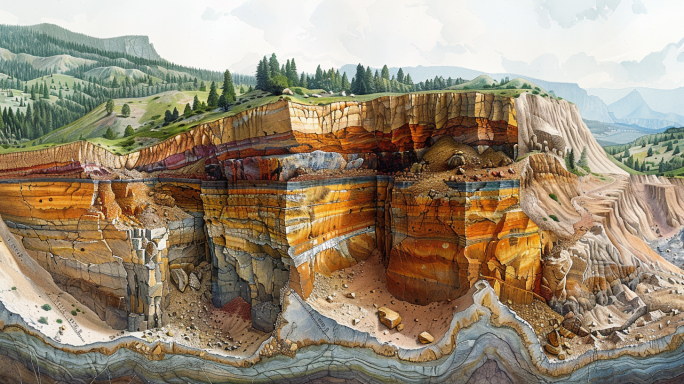Introduction
The Great Unconformity is a geological enigma that has puzzled scientists for decades. This phenomenon is characterized by a significant gap in the geological record, where millions of years of rock layers are mysteriously missing. Found in various locations worldwide, the Great Unconformity raises questions about the Earth’s history and the processes that shaped its surface. Recent studies have proposed various theories, such as massive glacial erosion during the Snowball Earth period or tectonic activity, to explain this perplexing occurrence. Despite these hypotheses, the true cause of the Great Unconformity remains a topic of intense debate and research.
Understanding the Great Unconformity
Definition and Discovery
The Great Unconformity refers to a widespread gap in the geological record where rock layers from specific periods are missing. This phenomenon was first identified by geologist John Wesley Powell in the late 19th century during his exploration of the Grand Canyon. He noticed a striking boundary between ancient Precambrian rocks and overlying younger Paleozoic rocks, with a substantial time gap between their formations.
Global Occurrence
The Great Unconformity is not limited to the Grand Canyon. It has been observed in various locations worldwide, including North America, Europe, Asia, and Africa. This widespread presence indicates that the processes responsible for the Great Unconformity were global in scale, affecting multiple continents and geological settings.
Theories Behind the Great Unconformity
Glacial Erosion Hypothesis
One of the leading theories to explain the Great Unconformity is massive glacial erosion during the Snowball Earth period, which occurred around 700 million years ago. During this time, the Earth experienced extreme glaciation, with ice sheets covering much of the planet. The intense glacial activity could have eroded vast amounts of rock, removing layers that represented millions of years of geological history.
Tectonic Activity Hypothesis
Another plausible explanation involves tectonic activity. The movement of tectonic plates can lead to the uplift, erosion, and subduction of rock layers. These processes can create significant gaps in the geological record. The collision of continents, the formation of mountain ranges, and the opening and closing of ocean basins are all tectonic events that could contribute to the formation of the Great Unconformity.
Combination of Factors
Some researchers propose that the Great Unconformity may result from a combination of glacial erosion and tectonic activity. The interplay between these processes could have amplified the effects, leading to the extensive removal of rock layers over millions of years.
Evidence and Research
Geological Field Studies
Geologists have conducted extensive field studies to understand the Great Unconformity better. By examining rock formations, fossils, and mineral compositions, researchers can reconstruct the geological history of affected regions. These studies provide valuable insights into the timing and extent of the missing rock layers.
Radiometric Dating
Radiometric dating techniques, such as uranium-lead dating, have been crucial in determining the ages of rock layers and the timing of the Great Unconformity. By dating the rocks above and below the unconformity, scientists can estimate the duration of the missing time and correlate it with known geological events.
Recent Discoveries
Recent research has uncovered new evidence supporting the glacial erosion hypothesis. Studies of ancient glacial deposits and the chemical composition of rocks suggest that intense glaciation during the Snowball Earth period played a significant role in shaping the Great Unconformity. However, these findings do not exclude the possibility of tectonic influences.
The Debate Continues
Conflicting Theories
Despite recent advancements, the cause of the Great Unconformity remains a topic of debate. Some scientists argue that glacial erosion alone cannot account for the extensive gaps observed in the geological record. Others believe that tectonic activity alone is insufficient to explain the phenomenon. The interplay between these factors and other potential processes continues to be investigated.
Implications for Earth’s History
Understanding the cause of the Great Unconformity is crucial for reconstructing Earth’s geological history. The missing rock layers represent significant gaps in our knowledge of past climates, ecosystems, and geological events. Resolving this mystery could provide valuable insights into the processes that shaped our planet and influenced the evolution of life.
Conclusion
The Great Unconformity remains one of geology’s most intriguing mysteries. While recent studies have shed light on potential causes such as glacial erosion during the Snowball Earth period and tectonic activity, the true reason behind this significant gap in the geological record remains elusive. Ongoing research and advancements in technology will likely continue to uncover new evidence, bringing us closer to solving this geological puzzle. Understanding the Great Unconformity is not only essential for reconstructing Earth’s history but also for appreciating the dynamic and ever-changing nature of our planet.
FAQs
1. What is the Great Unconformity?
The Great Unconformity is a significant gap in the geological record where millions of years of rock layers are missing. It is found in various locations worldwide and has puzzled scientists for decades.
2. What are the leading theories behind the Great Unconformity?
The leading theories include massive glacial erosion during the Snowball Earth period and tectonic activity. Some researchers propose a combination of these factors as the cause.
3. How was the Great Unconformity discovered?
The Great Unconformity was first identified by geologist John Wesley Powell in the late 19th century during his exploration of the Grand Canyon. He noticed a striking boundary between ancient Precambrian rocks and overlying younger Paleozoic rocks.
4. Why is the Great Unconformity significant?
Understanding the Great Unconformity is crucial for reconstructing Earth’s geological history. The missing rock layers represent significant gaps in our knowledge of past climates, ecosystems, and geological events.
5. What recent discoveries have been made regarding the Great Unconformity?
Recent research has uncovered new evidence supporting the glacial erosion hypothesis. Studies of ancient glacial deposits and the chemical composition of rocks suggest that intense glaciation during the Snowball Earth period played a significant role in shaping the Great Unconformity.

